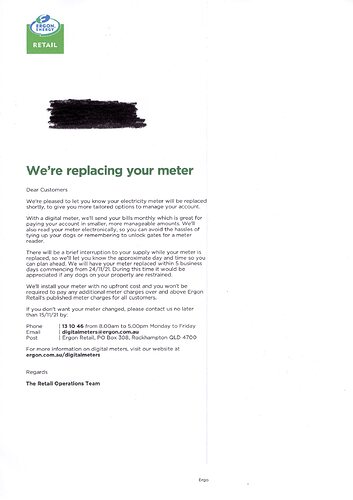Hi, I have heard a lot of comments on Smart meters and how once switching to a smart meter the consumer finds their electricity bill is quite a bit higher. Refer to Energy Price Fact Sheet below, these prices are before the July price rises of up to 20%.
As you can see the peak rate changes from 26.72571 cents per kWh all day to 53.98844 cents per kWh with a Smart meter during peak and Smart Meter shoulder rates change to 21.62446 cents per kWh. Peak 6hrs and shoulder 9hrs = 15 hrs per day. Off peak is from 10pm & 7am, Monday to Sunday = 9 hrs per day. This is generally when everyone is asleep except maybe for shift workers
It would appear that the electricity suppliers are the smart ones and the consumer the fool when switching to a smart meter. Hourly peak cost no smart meter = 26.72571 cents per kWh and smart meter average cost per hr peak & shoulder 34.57005 cents per kWh.
Electricity Charges: Peak
Applicable Charges Price (excl. GST) Price (incl. GST)
Usage - First 10.9589 kWh of Peak usage per day 24.2961 cents per kWh 26.72571 cents per kWh
Usage - Next 10.9589 kWh of Peak usage per day 23.747 cents per kWh 26.1217 cents per kWh
Usage - Balance of Peak daily usage > 21.9178 kWh 23.2079 cents per kWh 25.52869 cents per kWh
Daily Supply Charge 76.275 cents per day 83.9025 cents per day
Electricity Charges: Residential Time of Use (Smart Meter costs)
Applicable Charges Price (excl. GST) Price (incl. GST)
Usage - Peak usage per day – 49.0804 cents per kWh 53.98844 cents per kWh
Between 2pm & 8pm, Monday to Friday AEST / DST
Usage - Off-Peak usage per day (if applicable) 10.9429 cents per kWh 12.03719 cents per kWh
- Between 10pm & 7am, Monday to Sunday AEST / DST
Usage - Shoulder usage per day (if applicable) 19.6586 cents per kWh 21.62446 cents per kWh
- Between 7am & 2pm and 8pm & 10pm Monday to Friday,
7am & 10pm Saturday/Sunday and
Public Holidays AEST / DST 19.6586 cents per kWh 21.62446 cents per kWh
Usage - Dedicated Circuit usage per day (if applicable) 8.6648 cents per kWh 9.53128 cents per kWh
Daily Supply Charge 90.584 cents per day 99.6424 cents per day

